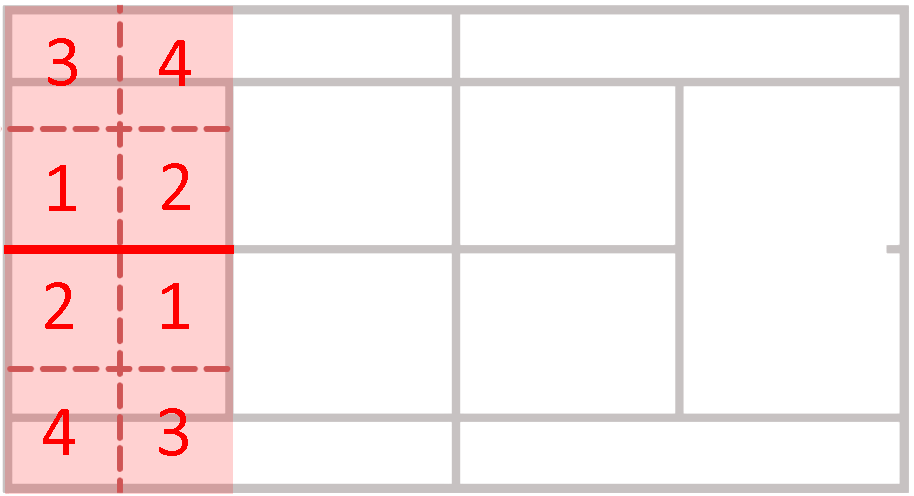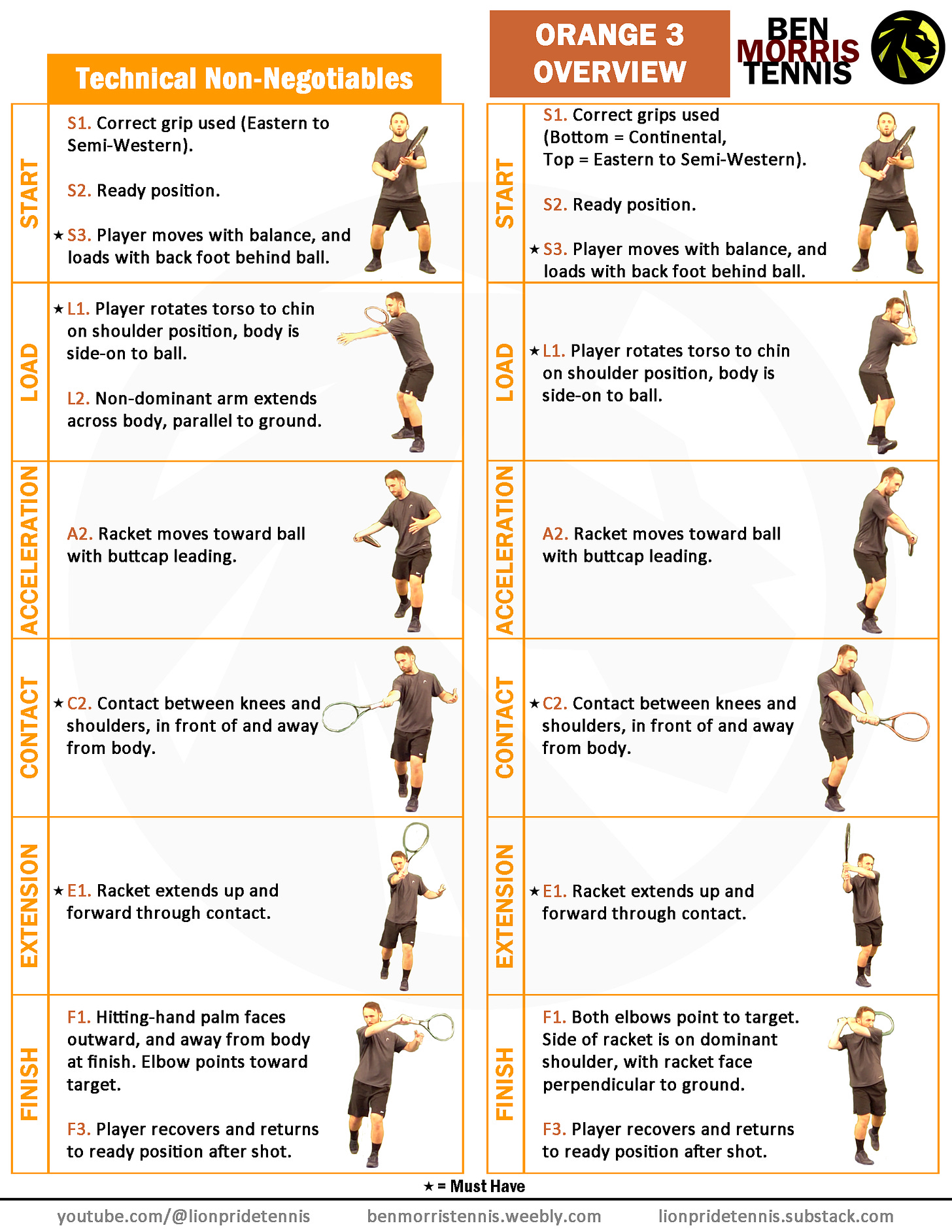This article begins an overview of the four stages of development used in the Lion Pride Tennis Method.
What is Stage 1?
As its name suggests, Stage 1 is the first stage of tennis development, beginning when players start tennis, and ending when they are able to serve, rally, and play matches independently. Unfortunately, Stage 1 is also the most difficult stage, as it contains the primary hurdle to playing the game, which is the ability to rally and control the ball within the court.
Ball Control Focus
Racket Skills & Self-Rally: Students learn to control the racket and perform a controlled solo rally using the following progressions:
Consistency: Students learn to demonstrate consistent control over the ball while rallying within the following court spaces. The court spaces are labeled with the location of the incoming ball first (1 > 2), and the outgoing target second (1 > 2). The court shapes are in order of difficulty, from least to most difficult.
Red Ball
-1 > 2 (Short Down the Line Forehand)
-2 > 1 (Short Down the Line Backhand)
-2/1 > 1/2 (Short Forehand & Backhand Mixed)
-3 > 4 (Long Down the Line Forehand)
-4 > 3 (Long Down the Line Backhand)
-3/4 > 4/3 (Long Forehand & Backhand Mixed)
-1/2/3/4 > 1/2/3/4 (Full Court Mixed)
Orange, Green & Yellow Ball
-1 > 2 (Short Down the Line Forehand)
-2 > 1 (Short Down the Line Backhand)
-1/2 > 2/1 (Short Forehand & Backhand Mixed)
-3 > 4 (Mid Down the Line Forehand)
-4 > 3 (Mid Down the Line Backhand)
-4/3 > 3/4 (Mid Forehand & Backhand Mixed)
-1/2/3/4 > 4/3/2/1 (Mid/Short FH/BH Mixed)
-5 > 6 (Long Down the Line Forehand)
-6 > 5 (Long Down the Line Backhand)
-2/1 > 1/2 (Long Forehand & Backhand Mixed)
-1/2/3/4/5/6 > 1/2/3/4/5/6 (Full Court Mixed)
Holistic Goals
Score and Play Tennis
At this level, players learn the basic rules necessary to play the actual game of tennis. Scoring and match length are adjusted based on players' ages and experience (E.g. 1-4 Scoring, No-Ad, Short Sets).
Parent Education
Parents are uniquely positioned to help their children practice at this level, as Stage 1 does not require any specific knowledge or ability. Simply hand feeding balls, or rallying short-short, is enough to jumpstart skill growth. Parents may also wish to familiarize themselves with the technical range of correctness, so that they are able to correct any inefficient habits.
I have created the following resources for parents of Stage 1 students:
Progress Expectation Survey
Stage 1 Self-Rally Progressions
Serve Progressions
Listening and Body Awareness
Because many of the skills in Stage 1 are taught implicitly through goal-based exercises, students who are able to follow directions and copy instructors tend to progress more quickly.
For example: A coach adjusts a player's grip on the serve. After helping other students, the coach returns to find the player has reverted to their previous inefficient grip. Therefore, the reps performed without the coach nearby have not improved the player's performance.
Fun
Fun is the primary reason that children participate in sport. For new players, fun is highly dependent on early success and connection with classmates and the instructor. Stage 1 is based around getting students playing, and enjoying, the game of tennis as quickly as possible.
Growth Mindset
Tennis is a difficult sport, requiring technical and athletic skills to play at even a basic level. Therefore, failure is expected (and encouraged). Feeling comfortable with failing is necessary , and players who are motivated and encouraged will improve. When children are successful, praise is directed towards their efforts, and not their results. This encourages the development of a "growth-mindset," where the student understands that achievement comes from their own hard work.
Reception Skills
Short/Deep: Players recognize when the ball will land short, and adjust their position accordingly.
Tactical Competencies
Consistency: At this stage, points are lost rather than won. Players win by keeping the ball in play longer than their opponent.
Technical Competencies
In Stage 1, players are taught simple swings that fall within the range of correctness allowed by the following technical guidelines. The focus is on the serve, forehand, and backhand, as these are the strokes required to play tennis at the beginner level. Strokes are taught from contact back through a series of progressions.
Further reading on Stage 1 technical development:
Offensive Situations
There are no intentional offensive situations in Stage 1.
Neutral Situations
Rally Mid > Mid
This is the most common rally pattern in Stage 1, as players do not have directional control over the ball. Players aim for the center of the court on rally balls, as it is the largest target with the most room for error.
Serve
Players must learn to hit overhand serves to the correct box in order to play tennis.
Return of Serve
Players are able to return serve to the center of the court, and position themselves appropriately after (near the center of, and behind the baseline).
Defensive Situations
Short Ball (Defense)
Players may inadvertently hit balls that land short in the court while rallying in Stage 1. It is important that players are able to handle these short balls.
Movement Demands
At this stage, movement is focused around a simple cycle of Ready Position > Movement to the Ball > Positioning around the Ball > Contact > Recovery to Ready Position. Emphasis is placed on the highlighted receptive skills, specifically lateral movement, limited forward movement, and receiving the ball at an appropriate contact point (between chest and knees).
To assist in meeting these goals, players are taught the following movement skills and contact moves:
Ready Position
Rhythm Step
A short series of shuffle steps used to move to close balls.
Lateral Shuffle
A footwork pattern used to move to balls landing wide on the court. The player shuffles out to the ball, before performing a Step Down contact move.
Contact Moves
Step Down
The player steps in with the non-hitting side foot, in a side-on position to the incoming ball.
Metrics
Beginner Stage 1 Sample Evaluation:
Tiebreak Test Levels 1 & 2



Rally Progression Checklist
Serve Sharpshooter Level 0
Competition
Formats: Competition at Stage 1 is comprised of low-pressure and informal match plays. Scores are not recorded, and emphasis is placed on play over winning/competing. The USTA recommends Team Tournaments and Junior Team Tennis Leagues for this level of player (once basic serving and rallying are learned).
Instruction
Stage 1 practices consist of simple drills and progressions intended to build reception and projection skills, as well as establish a technical base. Students often work with a partner, with one player feeding and the other hitting, or with both players attempting to maintain a controlled rally in the abovementioned court spaces. Athletic development is a large focus in Stage 1, especially with students 10 & under.
Parents are uniquely positioned to help their children practice at this level, as Stage 1 does not require any specific knowledge or ability. Simply hand feeding balls, or rallying short-short, is enough to jumpstart skill growth. Parents may also wish to familiarize themselves with the technical range of correctness, so that they are able to correct any inefficient habits.
Top juniors play 2-4 hours per week at this stage.
Practice Structure
-Warm-up + Athletic Skill Building
-Self & Partner Rally Progression
-Technical Training
-Court Space Training (e.g. 1 > 1) & Progressions (ideally to open match play)
Classes
The following are Stage 1 classes:
-Red 3 & 2
-Orange 3 & 2
-Green 2
-Middle School 3
-High School 3















